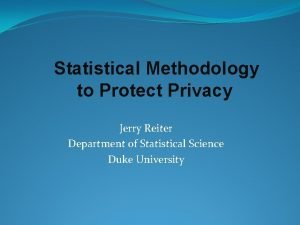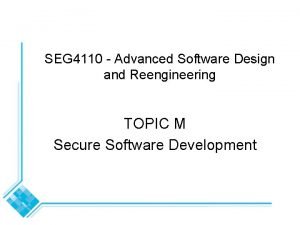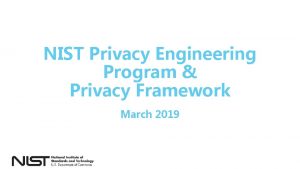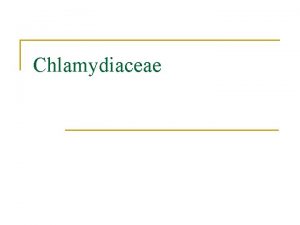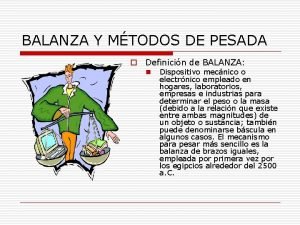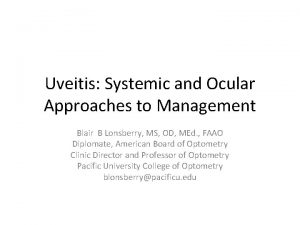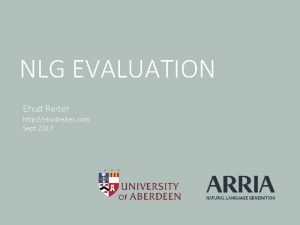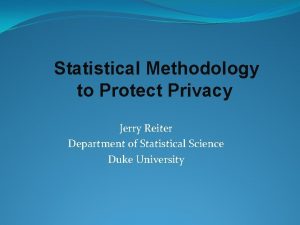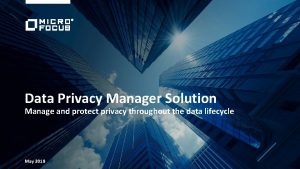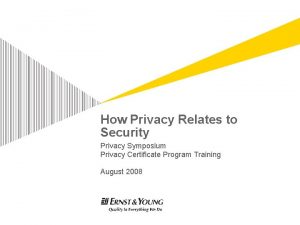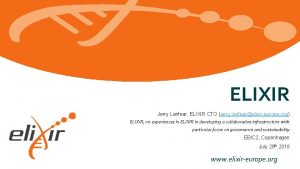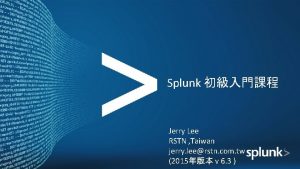Statistical Methodology to Protect Privacy Jerry Reiter Department

















- Slides: 17

Statistical Methodology to Protect Privacy Jerry Reiter Department of Statistical Science Duke University

Acknowledgments �Research ideas in this talk supported by �National Science Foundation � ACI 14 -43014, SES-11 -31897, CNS-10 -12141 �National Institutes of Health: R 21 -AG 032458 �Alfred P. Sloan Foundation: G-2 -15 -20166003 �US Bureau of the Census �Any views expressed are those of the author and not necessarily of NSF, NIH, the Sloan Foundation, or the Census Bureau

An argument for public use data �Record-level data are enormously beneficial for society �Facilitates research and policy-making �Trains students at skills of data analysis �Enables development of new analysis methods �Helps citizens understand their communities �Even in a world where analysis is brought to the data

Microdata: redaction strategies �Alter data before releasing them �Aggregate -- coarsen geography, top-code, collapse categories �Suppress data �Swap variables across records � Add random noise �High intensity perturbations degrade quality in ways that are difficult to unwind �Low intensity perturbations not protective

An alternative: Synthetic data �Fully synthetic data proposed by Rubin (1993) �Fit statistical models to the data, and simulate new records for public release �Low risk, since matching is not possible �Can preserve associations, keep tails, enable estimation at smaller geographical levels

Synthetic data products �Implementations by the Census Bureau �Synthetic Longitudinal Business Database �Synthetic Survey of Income and Program Participation �American Community Survey group quarters data �On. The. Map �Other implementations by National Cancer Institute, Internal Revenue Service, and national statistics agencies abroad (UK, Germany, Canada, New Zealand)

Longitudinal Business Database (LBD) �Business dynamics, job flows, market volatility, industrial organization… �Economic census covering all private non-farm business establishments with paid employees �Starts with 1976, updated annually �>30 million establishments �Commingled confidential data protected by US law (Title 13 and Title 26) 7

Synthesis: General approach �Generate predictive distribution of Y|X �f(y 1, y 2, y 3, …|X) = f(y 1|X)·f(y 2|y 1, X)·f(y 3|y 1, y 2, X) ··· �Use industry (NAICS) as “by” group �Models include multinomials, classification trees, nonparametric regressions. . 8

Variables used (Phase 2) 9

10


12

Limitations of synthetic data �Synthetic data inherit only features baked into synthesis models �Quality of results based on synthetic data dependent on quality of synthesis models �Synthetic data cannot preserve every analysis (otherwise we have the original data!) �Implementation is hard work. General plug-and-play routines? � Model based synthesis – yes, but hard to characterize disclosure risks beyond re-identification � Formally private synthesis – much theoretical development, but not much practical experience for complex datasets

The vision we are working towards �Integrated system for access to confidential data including �unrestricted access to fully synthetic data, coupled with �means for approved researchers to access confidential data via remote access solutions, glued together by �verification servers that allow users to assess quality of inferences from the synthetic data. 25

Synergies of integrated system �Use synthetic data to develop code, explore data, determine right questions to ask �User saves time and resources when synthetic data good enough for her purpose �If not, user can apply for special access to data �This user has not wasted time �Exploration with synthetic data results in more efficient use of the real data �Explorations done offline free resources (cycles and staff) for final analyses 26

Where are we now? �Allowable verifications depend on user characteristics �We have developed verification measures that satisfy differential privacy �Plots of residuals versus predicted values for regression �ROC curves in logistic regression �Statistical significance of regression coefficients �Tests that coefficients exceed user-defined thresholds �R software package in development �Open question: how to scale up while respecting privacy budgets 27

Concluding remarks �Implementing this idea on data from the Office of Personnel Management on the work histories of federal government employees �Synthetic data not yet approved for release � Manuscript on arxiv. org/abs/1705. 07872 �More information �Duke/NISS NCRN node: �The NCRN network: sites. duke. edu/tcrn/ ncrn. info
 Jerry reiter duke
Jerry reiter duke Protect privacy
Protect privacy Cvs privacy awareness and hipaa privacy training
Cvs privacy awareness and hipaa privacy training Nist privacy engineering
Nist privacy engineering Reiter’s syndrome
Reiter’s syndrome Balanza con pesas corredizas
Balanza con pesas corredizas Reiter’s syndrome
Reiter’s syndrome Keith reiter
Keith reiter Reactive arthritis
Reactive arthritis Diana reiter schindler's list
Diana reiter schindler's list Dr pugliese allergist
Dr pugliese allergist Lou reiter
Lou reiter Hans ulrich franck
Hans ulrich franck Jeff reiter
Jeff reiter Reiter sendromu triadı
Reiter sendromu triadı Ehud reiter
Ehud reiter Reiter’s syndrome
Reiter’s syndrome Karl reiter
Karl reiter
